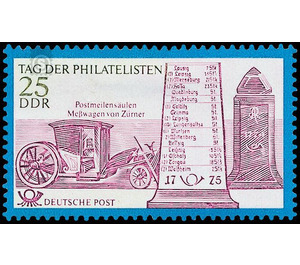Day of the philatelists - Germany / German Democratic Republic 1971 - 25 Pfennig
Theme: Devices, Items & Instruments
| Country | Germany / German Democratic Republic |
| Issue Date | 1971 |
| Face Value | 25.00 |
| Color | multi-colored |
| Perforation | K 14 |
| Printing Type | combined engraving and screen printing |
| Stamp Type | Postage stamp |
| Item Type | Stamp |
| Chronological Issue Number | 1446 |
| Chronological Chapter | GER-DDR |
| SID | 461235 |
| In 15 Wishlists | |
Day of the Philatelists 1971 For the Day of the Philatelists 1971, the Ministry of Posts and Telecommunications of the German Democratic Republic issued two special postage stamps, one of which was a supplement. The sums collected will be made available to the Philatelist Association of the GDR in the German Cultural Association. The "Philatelist Day" 1971 For the fifth time in 1971, GDR philatelists celebrate their "Philatelist Day", which replaced the former "Stamp Day". This year, on October 24, it will be marked by a variety of public events promoting philately and accounting for the cultural-political work of the Friends of Stamps and other postal documents. The two special stamps bring motifs that report on modern airmail transport and a chapter on postal history. 25 Pfennig Post Milestones, Measuring Vehicles by Zürner Kursächsische Postmeilensäulen are living witnesses of the postal and traffic history for today; as historical pieces of inspiration, they are under monumental protection. The first stone postmile columns were erected in the former Saxony from 1722. They should show the traveler the direction and distance of their destination, much like the street signs today. In this way, the mail columns have helped to create better traffic conditions. Four types of pillars were set up at that time: distance pillars outside the gates of the cities or marketplaces, half and half milestones and quarter milestones. The 25-pfennig mark shows the part of the column in Mittweida. This pillar owes its resurgence to the work of the research group "Kursächsische Postmeilensäulen" of the Philatelistenverband der DDR in the German Cultural Association. After a remnant of this former column was found in 1965, the research group initiated the rebuilding of the supplemented column in 1969. The quarter milestone shown on the stamp is also in Reitzenhain. In the 18th century, Adam Friedrich Zürner (1679-1742) used a self-constructed "Geometric Carriage" to measure the streets of the Saxony axis, which was necessary for the exact erection of the columns, and which can also be seen on the stamp. Zürner, by profession pastor, later land geographer and land and border commissioner, not only drew a large number for the time of first-class maps, but created by his surveying and the documents for the distance information on the post-Electoral columns. In the inscriptions, a Saxon postal or police milieu of 9.062 kilometers in length was equated to two "hours", whereby an "hour" was not used as a term but as a distance indication. In addition, Zürner himself led the entire lineup of post pillars in Saxony. In 1972, the Electoral Post Milestones of Colonia have their 250th anniversary, which gives occasion to commemorate a man like Adam Friedrich Zürner, who entered the post and traffic history of our homeland with his work.


